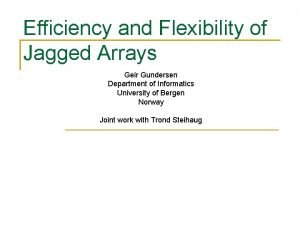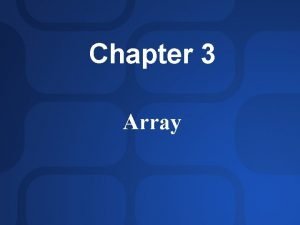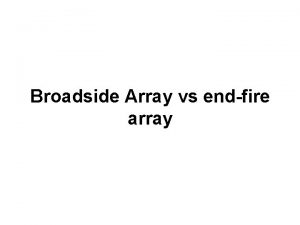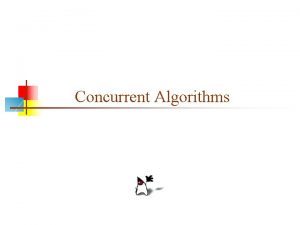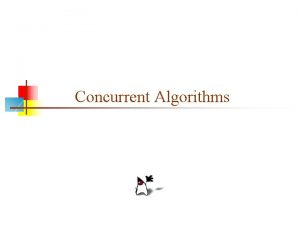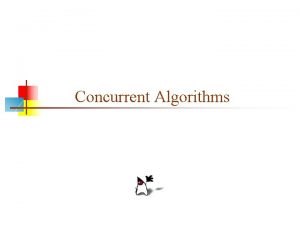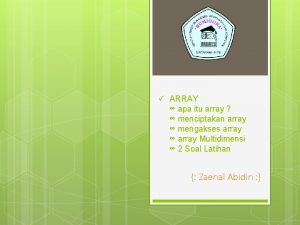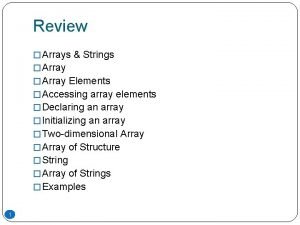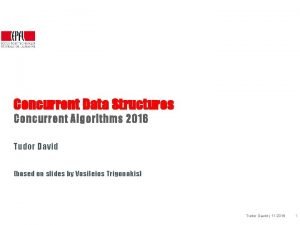Concurrent Algorithms Summing the elements of an array











- Slides: 11

Concurrent Algorithms

Summing the elements of an array 76 35 41 10 7 25 3 15 31 10 13 10 18 6 4 2

Parallel sum and parallel prefix sum n It’s relatively easy to see how to sum up the elements of an array in a parallel fashion n n It’s harder to see how to do a prefix (cumulative) sum n n For example, the list [3, 1, 4, 1, 6] to [3, 4, 8, 9, 15] This is a special case of what is sometimes called a scan operation An example is shown on the next slide The algorithm is done in two passes: n n n This is a special case of a reduce operation—combining a number of values into a single value The first pass is “up” the tree, retaining the summands The second pass is “down” the tree Note: These two examples are from Principles of Parallel Programming by Calvin Lin and Lawrence Snyder 3

Summing the elements of an array 0 76 = 35 + 41 35 (0+35) 0 35 = 10 + 25 41 = 31 + 10 10 (0+10) 66 (35+31) 35 0 10 = 7 + 3 25 = 15 + 10 25 (10+15) 7 10 0 7 7 3 10 15 25 10 35 13 48 31 = 13 + 18 35 48 (41+13) 18 66 6 72 10 = 6 + 4 66 72 4 76 4

Batcher’s Bitonic sort n Batcher’s bitonic sort is a sorting algorithm with the following characteristics: n n n It’s a variation of Merge. Sort It’s designed for 2 n processors It fully occupies all 2 n processors n n Unlike array sum, which uses fewer processors on each pass I’m not going to go through this algorithm—I just want you to be able to say you’ve heard of it 5

Map. Reduce n n Map. Reduce is a patented technique perfected by Google to deal with huge data sets on clusters of computers From Wikipedia: n n n "Map" step: The master node takes the input, chops it up into smaller sub -problems, and distributes those to worker nodes. A worker node may do this again in turn, leading to a multi-level tree structure. The worker node processes that smaller problem, and passes the answer back to its master node. "Reduce" step: The master node then takes the answers to all the subproblems and combines them in a way to get the output - the answer to the problem it was originally trying to solve. Hadoop is a free Apache version of Map. Reduce 6

Basic idea of Map. Reduce n In Map. Reduce, the programmer has to write only two functions, and the framework takes care of everything else n n The Map function is applied (in parallel) to each item of data, producing a list of key-value pairs The framework collects all the lists, and groups the key-value pairs by key The Reduce function is applied (in parallel) to each group, returning either a single value, or nothing The framework collects all the returns 7

Example: Counting words (Python) n The following Python program counts how many times each word occurs in a set of data, and returns the list of words and their counts n n def mapper(key, value): words=key. split() for word in words: Wmr. emit(word, '1') def reducer(key, iter): sum = 0 for s in iter: sum = sum + int(s) Wmr. emit(key, str(sum)) 8

Example: Counting words (Java) n * Mapper for word count */ n class Mapper { public void mapper(String key, String value) { String words[] = key. split(" "); int i = 0; for (i = 0; i < words. length; i++) Wmr. emit(words[i], "1"); } } /* Reducer for word count */ class Reducer { public void reducer(String key, Wmr. Iterator iter) { int sum = 0; while (iter. has. Next()) { sum += Integer. parse. Int(iter. next()); } Wmr. emit(key, Integer. value. Of(sum). to. String()); } } 9

Example: Average movie ratings n #!/usr/bin/env python def mapper(key, value): avg. Rating = float(value) bin. Rating = 0. 0 if (0 < avg. Rating < 1. 25): bin. Rating = 1. 0 elif (1. 25 <= avg. Rating < 1. 75): bin. Rating = 1. 5 elif (1. 75 <= avg. Rating < 2. 25): bin. Rating = 2. 0 elif (2. 25 <= avg. Rating < 2. 75): bin. Rating = 2. 5 elif (2. 75 <= avg. Rating < 3. 25): bin. Rating = 3. 0 elif (3. 25 <= avg. Rating < 3. 75): bin. Rating = 3. 5 elif (3. 75 <= avg. Rating < 4. 25): bin. Rating = 4. 0 elif (4. 25 <= avg. Rating < 4. 75): bin. Rating = 4. 5 elif (4. 75 <= avg. Rating < 5. 0): bin. Rating = 5. 0 else: bin. Rating = 99. 0 n #!/usr/bin/env python def reducer(key, iter): count = 0 for s in iter: count = count + 1 Wmr. emit(key, str(count)) Wmr. emit(str(bin. Rating), key) 10

The End 11
 Synchronization algorithms and concurrent programming
Synchronization algorithms and concurrent programming Jagged array
Jagged array Keuntungan dari sparse array adalah
Keuntungan dari sparse array adalah Associative array vs indexed array
Associative array vs indexed array Array 1 dimensi dan 2 dimensi
Array 1 dimensi dan 2 dimensi Pin grid array
Pin grid array Broadside vs endfire
Broadside vs endfire Photovoltaic array maximum power point tracking array
Photovoltaic array maximum power point tracking array Array angular
Array angular Arik adalah
Arik adalah Summing junction flowchart
Summing junction flowchart Jacobian
Jacobian

